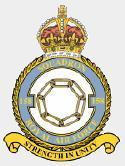Corgi AA37204 RAF Handley Page Halifax Mk. III Heavy Bomber - "Friday the 13th", No.158 Squadron, RAF Lisset, Yorks, 1944-45 (1:72 Scale)
"Strength in Unity"
- Motto of No.158 Squadron
 The Handley Page Halifax was one of the British front-line, four-engine heavy bombers of the Royal Air Force during the Second World War. A contemporary of the famous Avro Lancaster, the Halifax remained in service until the end of the war, performing a variety of duties in addition to bombing. The Halifax was also operated by squadrons of the Royal Australian Air Force, Royal Canadian Air Force, Royal New Zealand Air Force and Polish Air Force.
The Handley Page Halifax was one of the British front-line, four-engine heavy bombers of the Royal Air Force during the Second World War. A contemporary of the famous Avro Lancaster, the Halifax remained in service until the end of the war, performing a variety of duties in addition to bombing. The Halifax was also operated by squadrons of the Royal Australian Air Force, Royal Canadian Air Force, Royal New Zealand Air Force and Polish Air Force.
The Halifax entered service with No. 35 Squadron RAF at RAF Linton on Ouse in November 1940 and its first operational raid was against Le Havre on the night of 11-12 March 1941. In service with RAF Bomber Command, Halifaxes flew 82,773 operations, dropped 224,207 tons of bombs and lost 1,833 aircraft. (Wings Encyclopedia of Aviation, Orbis, 1979) In addition to bombing missions, the Halifax served as a glider tug, electronic warfare aircraft for No. 100 Group RAF and special operations such as parachuting agents and arms into occupied Europe. Halifaxes were also operated by RAF Coastal Command for anti submarine warfare, reconnaissance and meteorological roles.
Total Halifax production was 6,176 with the last aircraft delivered in November 1946. In addition to Handley Page, Halifaxes were built by English Electric, Fairey Aviation, Rootes Motors and the London Aircraft Production Group. Peak production resulted in one Halifax being completed every hour.
Post-WWII, Halifaxes remained in service with the RAF Coastal Command and RAF Transport Command and the
Armée de l'Air until early 1952. The Pakistan Air Force which inherited the planes from the RAF continued to use the type until 1961. A transport/cargo version of the Halifax was also produced, the Handley Page Halton.
Pictured here is a 1:72 scale replica of a RAF Handley Page Halifax Mk. III heavy bomber nicknamed "Friday the 13th", which was attached to No.158 Squadron, and based at RAF Lisset, Yorks, from 1944-45.
Dimensions:
Wingspan: 17-1/4-inches
Length: 12-inches
Release Date: October 2008
 Historical Account: "Friday the 13th" - Yorkshire, England, was the home of 4 and 6 Groups Bomber Command while three Halifax Squadrons were based at Elvington: first 77 Squadron, then two French Air Force Squadrons, 346 (Guyenne) and 347 (Tunisie).
Historical Account: "Friday the 13th" - Yorkshire, England, was the home of 4 and 6 Groups Bomber Command while three Halifax Squadrons were based at Elvington: first 77 Squadron, then two French Air Force Squadrons, 346 (Guyenne) and 347 (Tunisie).
The Yorkshire Air Museum's Halifax reconstruction is based on a section of the fuselage of Halifax II, HR792, which carried out an emergency landing on the Isle of Lewis in 1945. A crofter, Mr McKenzie, purchased the fuselage section for use as a hencoop. The wings came from Hastings, TG536, at RAF Catterick. The reconstruction is named "Friday the 13th" in honor of Halifax, LV907, which completed 128 operations with 158 Squadron, and is representative of all examples built. (courtesy: Yorkshire Air Museum)









